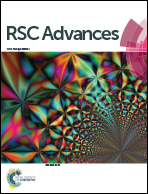Polymethylmethacrylate doped with porphyrin and silver nanoparticles as light-activated antimicrobial material
Abstract
Light-activated antimicrobial materials based on polymethylmethacrylate doped with porphyrin and silver nanoparticles were prepared and studied. The inspiration for the material design originates from photodynamic therapy where light is used to destroy pathogen microbes. Antimicrobial response of the materials is controlled by blue light illumination. Porphyrin molecules serve as light absorbers with dual antimicrobial response under illumination they produce reactive oxygen and affect the kinetics of silver release from the polymer. Silver is responsive for the antimicrobial effect, for the protection of porphyrin against photobleaching and for the conservation of energy through suppression of porphyrin luminescence. Triggerable and enhanced antimicrobial response of the material is activated through several possible mechanisms, including local heating of the polymer matrix, transfer of the excited state from porphyrin to silver and the synergetic effect of reactive oxygen and silver. In a passive state the material exhibits weak antimicrobial response against Gram-negative bacteria. In an active state, however, it is fatal for both Gram negative and Gram positive bacteria.


 Please wait while we load your content...
Please wait while we load your content...